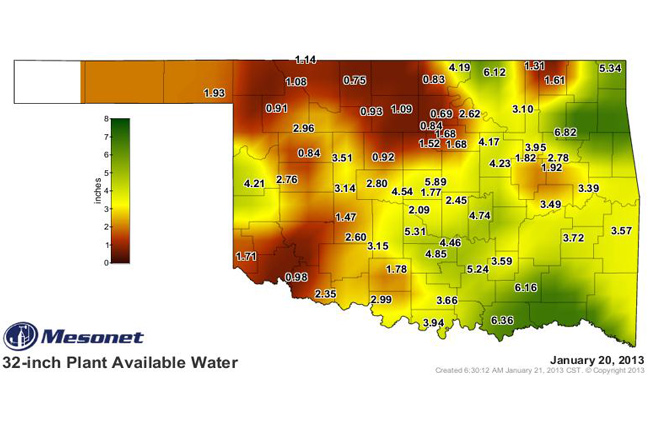
Agricultural News
Let Nature Take its Course on Drought-Impacted Pastures
Fri, 01 Feb 2013 12:46:21 CST

The following article was written by Jason Warren and Daren Redfearn and appeared in the OSU Department of Plant & Soil Sciences Extension Newsletter.
Recently, we were asked if the droughty conditions experienced in the past few years could have any significant negative impact on the physical characteristics of pasture soils. The answer to this question is YES. The fact is that they are very dry, but not compacted. The Mesonet map below shows that plant available water to a depth of 32 inches is less than 3 inches in western Oklahoma. There are regions of moist soil but in general the soils covered by perennial grasses (most often the ground cover for Mesonet sites) are dry.
In most cases this problem could quickly be corrected with the return of normal or above normal rainfall to recharge these soils.
The dryness of pasture soils is a concern that many producers have. Dry soils are hard and can be interpreted as being compacted. However, the fact is that compaction from cattle is actually unlikely during a drought because dry soil is difficult to compress for the same reason that it is difficult to dig through.
The drought and dry soil conditions experienced over the last two years could have certainly had indirect impacts on soil properties due to an increased likelihood of overgrazing. Overgrazing causes a number of negative impacts on soil. First, overgrazing reduces ground cover (litter) and increases the likelihood of crusting during rainfall events. This decreases water infiltration and can prolong plant recovery following a drought or at the very least limit recovery from drought conditions. Additionally, the reduced aboveground biomass in overgrazed pastures equates to reduced root growth below the ground. This causes potential for further degradation of the surface soil. Specifically, the loss of root biomass increases the likelihood that macropores can be crushed or more likely filled with sediments washed from the soil surface. This can increase crusting that is not experienced in moderately grazed pastures.
It may be tempting to take action to physically remediate the negative impacts of overgrazing using an aerator, disk, chisel or deep tillage implement. However, the best course of action will be to remove the cattle and let nature take its course until appropriate growing conditions return.
Aerating, disking, or any tillage will cause additional damage to the structure of pastured soils. Tillage will artificially, increase permeability and water infiltration for a short period, however it can cause loss of organic matter. This can in turn cause a decrease in macroporosity and actually results in a greater susceptibility to compaction, not to mention the exposure to erosion that tillage will cause. Pasture aerators have been marketed to provide a low disturbance option for increasing water infiltration into pastures. However, research studies from Oklahoma and other states have shown that they have only marginal impacts on water infiltration and have not resulted in improved forage production. Also, if soil moisture is sufficient to allow an aerator to penetrate the soil it is likely that your pasture is on its way to recovery.
It is hard to accept that we can do little to improve the soil conditions found in our drought stricken pastures to improve forage production. But generally, the best course of action is to let nature take its course. Only if overgrazing or fire has disturbed the soil such that excessive erosion has occurred, will some intervention to roughen the soil surface to reduce wind erosion be needed to establish growing ground cover.
WebReadyTM Powered by WireReady® NSI
Top Agricultural News
More Headlines...




















